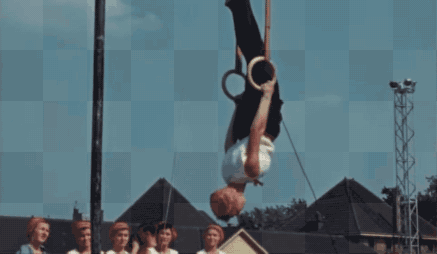
Vault, bars, beam, and floor.
Not until Helsinki 1952 did the four women’s events we know today became codified as THE EVENTS in Olympic competition. Before that, it was basically a free-for-all, the apparatuses in Olympic competition varying wildly from quadrennium to quadrennium with formats and rules that could at best be described as ambiguous. And at worst as a lawless mayonnaise fire.
In 1928, the women’s gymnastics rules were simply, “each country is entirely free in its choice of exercises, apparatus, and jumps.” (Thank you?)
In 1932, the rules were simply…um nothing because women couldn’t compete in gymnastics in 1932. Great work again, Los Angeles.
At the London Olympics of 1948, the women’s gymnastics program changed drastically again and featured an apparatus that had not been used before and would never be used again: rings.
While men had competed on rings at every Olympics dating back to 1896, women had only just been permitted to compete individual routines for the first time in 1936 (the previous Olympics). The three apparatuses at that point were vault, beam, and bars.
When the Olympics resumed again in 1948, rings replaced bars as the third women’s event. (And what a different future that would have been.) Even then, rings was clearly treated as the afterthought of the three pieces. While women competed compulsory routines and optional routines on both vault and beam, they competed only a compulsory routine on rings.
When all the event scores were then combined with the results from the two group-exercise events—one a calisthenics performance with jump rope and prancing and cartwheels and whatnot, the other a precursor to modern rhythmic gymnastics with hand apparatuses—to determine the team standings (no individual medals were given to women in 1948), the scores on rings had only the smallest influence on the overall result.
Wild inconsistencies and controversies in the scoring of women’s rings also betrayed its afterthought status. The bronze-winning US delegation lodged a particular complaint about the scoring of national champion Clara Schroth’s routine, which had a judging range from 7.3 to 9.0, while the observing members of the men’s technical committee deemed the routine to warrant 9.5 (at least as reported by US team manager George Gulack).
So…same shit as usual? NCAA is like, “And…?”
Sadly, this led Mr. Gulack and those members of the men’s technical committee to observe, “Women were not qualified to act as judges…this should not be done in the future.” Which is great. Great great great.
Maybe there were no effective rules, training, or familiarity with any kind of judging standard for them to use or…no? Just…woman bad? OK. The president of the women’s technical committee, Marie Provaznikova, was particularly criticized for not being present to adjudicate when inquiries were lodged. Turns out, she was a little busy defecting from Czechoslovakia to the UK.
The drama of rings competition at the 1948 Olympics would never be repeated. At the 1950 world championships—and every world championship and Olympic competition thereafter—the four women’s events were vault, bars, beam, and floor. Women’s rings died that night at the Empress Hall.
But if women had been allowed to receive awards for individual performance in 1948, the rings medalists would have been Zdenka Honsova of Czechoslovakia, who dominated the competition for gold with 9.6, with Edit Weckinger of Hungary and Laura Micheli of Italy tying for silver with 9.35. Special recognition would also go to 4th-place rings finisher Miroslava Milaskova of Czechoslovakia, whose younger sister (also on the team) died of polio the morning of the competition.
Meanwhile, women’s liaison officer Ada Sackett remarked that the most popular foods among the American female athletes at the games were ice cream, chocolate bars, butter, whole eggs, and fruit. So take that, Martha.

Love it — I’ll take a diet of “ice cream, chocolate bars, butter, whole eggs, and fruit” any day, especially if it would let me do rings! Yikes on the polio death tho.
Spencer, can you please tell us where you found this footage? I need to see MORE
Oh, women still do rings in Switzerland:
https://www.youtube.com/watch?v=Xswu2g-oRcI
mandatory chocolate of course…
That’s pretty much what I did as a child. I didn’t do it outside, though, and not in Switzerland either. That would have made it even more fun!
It is so much more fun when they swing!!
I did rings as a child. It was my favourite event by far!
Glad we have vaccines nowadays so we won’t have to hear things like ‘Sloane Blakely competed well despite Skye Blakely dying of polio this morning.’
except we have all these psychopaths who stupidly believe they cause autism.
Actually the rings were done in the 1950 World Championships. They decided that since bars were new women could choose which one for that event. The event was shared between Gertrude Kolar of Austria and Anne-Sofi Pettersen of Sweden and I believe both did the rings (I knoe for a fact Kolar did) and bronze medalist Rakoczy did bars.
I didnt see any iron cross in that vid 🙂
Re. the food: America had pretty strict rationing during WWII (and Great Britain continued rationing through the 1950s), and all of those foods were hard to get and very special through at least 1946. So they probably were still pretty novel (as well as undeniably delicious), and so it makes sense that they would have been notably popular among the athletes.
In all honesty, I like how you think, how you write what you think. I just don’t like what you think 🙂
But I won’t hold that against you, respect is on the method, not the believe!
Thank you.
The methods are good. you need to be passionate to win